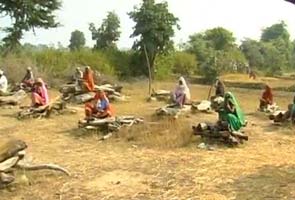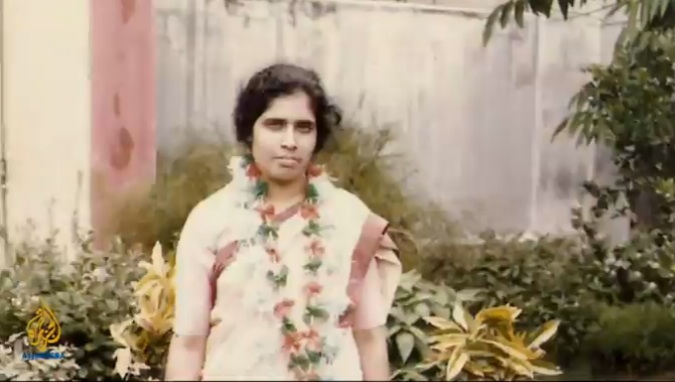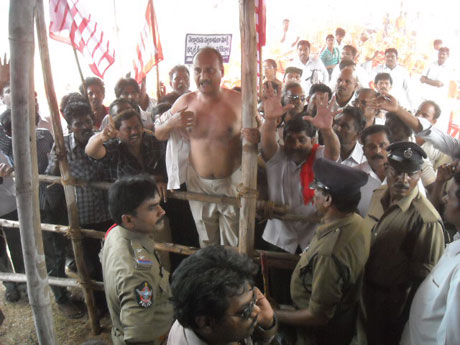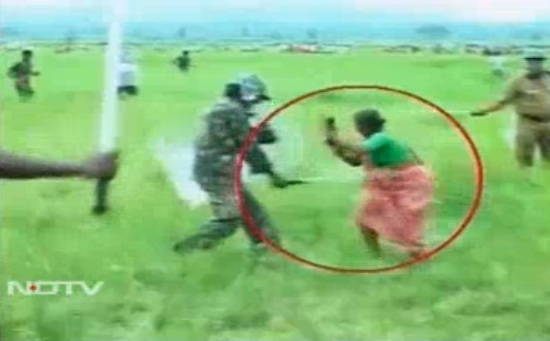Fatalities at anti-coal protests
|
This article is part of the Coal Issues portal on SourceWatch, a project of Global Energy Monitor and the Center for Media and Democracy. See here for help on adding material to CoalSwarm. |
Over the past decade, at least 28 people have been killed in anti-coal protests or in violence against anti-coal organizers in India and Bangladesh.
Contents
- 1 February 2017: One killed, a dozen injured at Bangladesh protest
- 2 October 2016: Four killed, 40 injured at Jharkhand mine demonstration
- 3 August 2016: Two killed, 40 injured at plant protests in Jharkhand's Ramgarh district
- 4 April 2016: Four or five killed in Chittagong, Bangladesh
- 5 July 2013: One killed, others injured in Jharkhand protest
- 6 November 2012: Woman immolates herself in protest against land acquisition for Katni power station in Madhya Pradesh
- 7 November 2011: Activist nun who fought Indian mining companies brutally murdered in Jharkhand
- 8 August 2011: Farmer killed in demonstration against Gobindpura power station in Punjab
- 9 April 2011: Six killed in protests against anti-encroachment drive in Jharkand
- 10 February 2011: Two killed, 25 injured in Andhra Pradesh
- 11 January 2011: Farmer killed in Bihar protest
- 12 July 2010: Two killed, 150 injured in Andhra Pradesh
- 13 August 2006: Three killed in protest against Phulbari coal mine (Bangladesh)
- 14 Resources and articles
February 2017: One killed, a dozen injured at Bangladesh protest
One person was killed about "about a dozen" were injured at a protest on February 1, 2017, against the 1200 MW S Alam power Chittagong power station in Bangladesh. According to Nurul Mostafa, a leader of a citizens group opposing the plant, protesters were chanting slogans when police attacked them.[1]
October 2016: Four killed, 40 injured at Jharkhand mine demonstration
Police fired on demonstrators protesting coal mining at Chirudih village near Hazaribagh, Jharkhand. According to an initial reports based on a police account, the incident resulted in four deaths among protesters as well as injuries to five villagers and seven policemen. (The Wire reported that the shootings resulted in six deaths but subsequently revised the death toll to four.) Protesters claimed that as many as 40 people had been injured. Among the injured were a superintendent of police and a circle officer. According to accounts by residents of Chirudih village, more than a thousand villagers were sleeping at the protest site when five companies of police and one company of the Rapid Action Force were deployed and began forcibly clearing the area. As more villagers arrived, the police first used tear gas and then live ammunition. According to police, gunfire was only used in self-defense. A spokesman from the Ekta Parishad resistance organization acknowledged that protesters had charged the police but said that there were no serious injuries to the police as a result. Among those arrested were Congress MLA Nirmala Devi. The events followed months of resistance against acquisition of agricultural land and forest areas for coal mining by NTPC, India's state-owned power company, including Chita Satyagraha (protesting on unlit funeral pyres).[2][3] A report by Amnesty India described the police action as follows:[4]
- On October 1, four people, including three teenagers, were killed and more than 40 persons injured when police personnel shot live ammunition following protests over the mine in the village of Darikalan. Some of the protestors had thrown stones at the policemen.
- The police said that they had been attacked by violent protestors, and had resorted to firing live ammunition only after giving adequate warning. However, eyewitnesses said that the firing began without any warning, and the police did not distinguish between protestors throwing stones and others. Eyewitnesses said that the four people killed were not involved in the protests. “They were even firing at people trying to retrieve the bodies,” said R Khatun, an eyewitness to the incident from the village of Darikalan.
- “Every single body we examined was shot above the waist and in the back, which shows that they were running away from police and not trying to attack them,” said Gopinath Ghosh and Alice Cherowa of Jharkhand Mine Areas Coordination Committee, a Ranchi-based organisation which examined the bodies of three of those killed. As of 21 October, the families of the victims were yet to receive copies of the post mortem reports.
- Local residents also say that the police had assaulted villagers in the days following the firing. Shazia from Cheppakalan village said that on 3 October, “The police came banging on our doors, shouting horrible abuses, saying that just you watch, you threw stones at our officers. Now this place will become a funeral pyre.”
- Four women from the village of Darikalan said that police forcibly entered their homes on 3 October and beat them with batons. “Women and elderly in my household were beaten, and 9 male family members were picked up and later released,” said Mohammed Rafique from Cheppakhurd village. “The whole village was empty for days, as people fled to their relatives’ houses in fear,” said Ilias Ansari of the Karanpura Bachao Sangharsh Samiti, a local peoples’ movement against the mine.
- The Superintendent of Police from Hazaribagh, when interviewed on 3 October, said, “Senior officials, including the additional district magistrate, are leading the troops into villages, and I don’t expect them to behave irresponsibly. Arrests are being made in connection with atrocities committed against the police.”
- “Jharkhand authorities must look into allegations that the police used unnecessary and excessive force during the protests, and assaulted villagers later,” said Aruna Chandrasekhar.
August 2016: Two killed, 40 injured at plant protests in Jharkhand's Ramgarh district
Two people were killed and 40 injured when police fired on protests in Gola, approximately 53 km from Ranchi in Jharkhand's Ramgarh district. The villagers were protesting the Gola power station, which is currently under construction. The shooting followed a policy confrontation with a crowd of 3,000 to 4,000 plant protesters, who were demanding compensation and jobs for the land acquired by Inland Power for the coal plant..[5]
April 2016: Four or five killed in Chittagong, Bangladesh
On April 4, 2016, four or five people were killed after police opened fire on villagers as a protest against a a power station being developed by S. Alam in Chittagong, Bangladesh. The killing took place after 500 villagers had gathered in Gandamara, to protest the potential displacement of thousands of villagers due to the proposed construction of two coal-fired power plants. According to local authorities, police claimed that the shootings occurred when protesters attacked them at a banned protest. The victims included a pair of brothers, according to district police chief Hafiz Akter. In addition to the four fatalities, dozens of protests were reported injured, as well as 11 policemen, one of whom was shot in the head. Witnesses put the death toll at five people and the number injured at 100. Witnesses estimated the the crowd at around 15,000 protesters. According to Dr. Saiful Islam of Chittagong Medical College Hospital, seven people, including four who were shot by live rounds, were brought to his clinic. According to protest leader Abu Ahmed, "Police opened fire as we brought out a procession against the power plants. They even chased the villagers to their homes." The protests occured when S. Alam Group began purchasing land for the plants. Two Chinese firms -- SEPCOIII Electric Power and HTG -- are financing $1.75 billion of the the plants' estimated $2.4 billion cost, the newspaper said.[6]
July 2013: One killed, others injured in Jharkhand protest
In May 2012 it was reported that "20 villages in Hazaribagh district of Jharkhand called a maha-panchayat and resolved not to let Reliance Power mine coal from Kerendari B and C blocks for its 4,000 MW power plant." The coal mine, which will source coal for the Tilaiya Ultra Mega Power Project, will not only displace an entire village, it will also impact the fertile agricultural land in the nearby villages.[7] According to a letter of complaint by the Jharkhand Human Rights Movement (JHRM), police fired on protesters on July 23, 2013 at Pagar village, Hazaribagh district, Jharkhand, killing protester Kesar Mahato and causing several injuries. JHRM asked Satyabrata Pal, a member of the National Human Rights Commission, to investigate and take action in response to the incident.[8]
November 2012: Woman immolates herself in protest against land acquisition for Katni power station in Madhya Pradesh
In November 2012, NDTV reported that twenty farmers in Bujbuja village sit every day on funeral pyres with kerosene and match sticks at arm's reach to protest acquisition of land for the Katni power station.[9] On Diwali, Katni district villager Sunia Bai died one day after she set herself on fire on Diwali day, in protest over land acquisition for the plant. Following the self-immolation, police responded to a protest by residents of Bujbuja and Dakaria villages with a lathicharge, seizing the body. According to villagers, the police had threatened to bulldoze the home of Sunia Bai and her husband Chhaka Gadari. In addition, police arrested 12 villagers as well as former Janata Dal (United) MLA Saroj Bachchan Nayak. Protesters demanded that land acquired for the project be returned to farmers. Farmers also built funeral pyres on their land and warmed that they would immolate themselves if forcibly evicted. A second villager threatened with eviction, Pyare Lai Choudhary, was admitted to the hospital after drinking poison in a suicide attempt.[10][11][12]
November 2011: Activist nun who fought Indian mining companies brutally murdered in Jharkhand
In mid-November 2011 Sister Valsa John, an anti-coal activist in India, was killed in her village of Pachwara, a small community in the eastern Indian state of Jharkhand. She was allegedly killed by individuals hired by coal mining companies. The individuals beat and hacked her to death. Sister Valsa was 52 and took her vows was a member of Sisters of Charity of Jesus and Mary. It was reported that on numerous occasions she had gone to the police after threats where made on her life. The following was written in the Globe and Mail following her death:
- "She was one of the remarkable breed of Indian religious figures who are grassroots social activists, who immerse themselves in the most marginalized and impoverished communities and work on literacy, basic health care and human rights. Sister Valsa said she did Jesus’s work by teaching the aboriginal people – known in India as adivasi or 'tribals' – about their rights to their land."[13]
On November 20, 2011 seven residents of Pachwara and adjoining Aloopara village, were arrested for the killing of Sister Valsa John. The Sister's family in the India region of Kerala had alleged she faced death threats from the "mining mafia" in the area and was killed because of her campaign against the Panam Coal Company. However, police alleged that that locals were responsible for her death instead.[14]
Prior to being killed, Sister Valsa John stood up for a rape victim in her community and a police report filed for the case. The alleged rapist, arrested days after the murder and later charged with that too, reportedly told the police that Sister Valsa was “an agent” of a private mining company.[15]
August 2011: Farmer killed in demonstration against Gobindpura power station in Punjab
A farmer was killed and others sustained injuries when police lathi-charged a larger group of farmers who were protesting the acquisition of land for the 1320 MW Gobindpura thermal station in Mansa district of Punjab. According to one report 10 farmers and 5 policemen were also injured.[16] According to another report, 30 farmers were injured.[17] Nearly 50 vehicles were also damaged in the police action. The farmer, 65-year-old Surjit Singh of Hamidi village in Barnala district, sustained severe injuries during the lathi charge and his body was later found in a field.[16] On August 3, thousands of people attended the last rites of Surjit Singh Hameedi, and MPs speaking at the ceremony demanded a judicial probe into the land acquisition as well as a probe into the killing. Jhanda Singh Jaithokey senior VP of the Bharatiya Kisan Union (Ugrahan), charged the government of Dhief Minister Parkash Singh Badal with receiving kickbacks from the company acquiring land for the plant.[18] On October 14, over 200 farmers were arrested while heading from Joga village toward the power project site, following a call to protest given by 17 farmers' unions.[19]
April 2011: Six killed in protests against anti-encroachment drive in Jharkand
The state of Jharkhand is home to one of the largest Adivasi (tribal) populations in India. It is also the location of an estimated 40% of the country’s deposits of coal, iron ore, uranium and other minerals. Jharkhand’s Adivasis have farmed and hunted on the land for millennia, but do not hold title deeds, but as the original inhabitants of the Indian subcontinent, Adivasis have ancient land rights protected by law. They are, however, being forced to leave their ancestral lands to make way for new mines, steel mills and hydroelectric projects, with little or no compensation.[20]
Following resistance by local residents against house demolitions at Matkoria, four people were killed in clashes with police attempting to clear land owned by Bharat Coking Coal Limited. In addition, 21 people were injured and 27 arrested.[21] Later, the overall death toll rose to six, with two killed in Dhanbad and two killed at Islam Nagar in Ranchi on April 5.[22] Among the arrested were former ministers Bacha Singh and OP lal, Congress MLA Manan Mallick, and deputy mayor Niraj Singh. A curfew was imposed on Dhanbad town. Among those killed in the fighting was Vikash Kuman, an auto driver.[21] Another fatality was that of Sanjay Paswan.[23]The protesters blocked National Highway 32 between Dhanbad and Bokaro for several hours. Police used lathis and teargas to disperse protesters. A Mob set fire to offices of Bharat Coking Coal Limited at Kunsunda and Godhar. Protesters also set on fire a police check post in Matkuriya as well as three police vehicles. Nine people were reported in critical condition with bullet wounds. Among the injured were a half dozen members of the media, including four camera men. Most of those being subjected to the anti-encroachment drive had settled in the area 80 years earlier.[24]
February 2011: Two killed, 25 injured in Andhra Pradesh
On February 28, 2011, in a set of clashes sparked by construction of the Bhavanapadu Thermal Power Project by East Coast Energy, police in Srikakulam fired into villagers, killing two people and injuring nearly 25 others. The plant at the center of the violence was in the same district as the coal plant where two people were killed the previous July 2010, protesting the Nagarjuna Construction Company Sompeta Thermal Plant. The dead were identified as Sirapu Yerraiah (36) of Sirapuvani Peta and J. Nageswara Rao (35) of Akashalakkavaram. At least two of the injured were hit at close range with rubber bullets. Police used guns, teargas, and lathis against villagers, who used stones and sticks. After police threw smoke bombs in Vadditandra village, 50 houses were gutted. A police jeep was burned by villagers.[25]
January 2011: Farmer killed in Bihar protest
In January 2011, a farmer involved in protests against the Nabinagar Super Thermal Power Project under construction in the Aurangabad district of Bihar was reportedly killed. According to the a report in The Times of India, the death occurred during "violent agitation" during which farmers "stoned a speeding train and clashed with police."[26] Also in January 2011, Bihar Pradesh Congress Committee (BPCC) president Chaudhary Mehboob Ali Qaiser condemned the lathicharge and tear-gassing of farmers demonstrating for adequate compensation for land, formed a four-member committee to inquire into the incident, and demanded the unconditional release of farmers held in custody.[27]
July 2010: Two killed, 150 injured in Andhra Pradesh
On July 14, 2010, police in Adhra Pradesh's Srikakulam district fired on farmers and fisherman protesting a 2,640 MW coal plant under construction by Nagarjuna Construction Company (NCC), killing two. In addition, 150 people were injured, including 45 policemen, during clashes between protesters and police. In the wake of the violence, police were deployed in about a dozen villages and banned assembly by more than five persons.[28]
August 2006: Three killed in protest against Phulbari coal mine (Bangladesh)
On August 26, 2006, more than 50,000 people took part in protests against the proposed mine. The Bangladesh Rifles, a paramilitary force, opened fire on the protesters. Three young men, Tariqul, son of the municipal commissioner and panel chairman, Ameen, a young carpenter, and Salehin of the adjoining upazila Nawabganj, died instantly. One to two hundred people are reported to have been injured. [29]
After the 2006 protest, a national strike closed down the country for four days. It ended when the government agreed to ban open-pit coal mining in Phulbari and kick the British company (then known as Asia Energy Corporation) out of the country—a pledge they have not fulfilled. Instead, the government plans to announce a new coal policy by June 2011, and Global Coal expects its mine to move forward. The National Indigenous Union and a broad coalition of human rights and environmental organizations are appealing for international support to stop the mine.[30]
Resources and articles
References
- ↑ Serajul Quadir, "One killed in Bangladesh protest against Chinese-backed plant," Reuters, February 2, 2017
- ↑ Ankush Vengurlekar, "Police Firing on Anti-Mining Protesters in Hazaribagh Kills Six," The Wire, October 1, 2016
- ↑ "Four killed in eastern India during coal mine protest," Channel NewsAsia, October 1, 2016
- ↑ "Communities affected by Jharkhand coal mine not adequately consulted," Amnesty International India, 27 October 2016
- ↑ "2 KILLED IN POLICE FIRING ON LAND PROTESTERS," The Pioneer, 30 August 2016
- ↑ "Four killed an anti-China power plant protest in Bangladesh," The Peninsula, April 5, 2016
- ↑ "Hazaribagh villages up against Reliance Power" Down to Earth, June 18, 2012.
- ↑ Ashok Shrimali, "Jharkhand rights movement writes to NHRC to probe police firing on protesters against thermal project," Counterview, July 26, 2013
- ↑ Siddharth Ranjan Das, "Madhya Pradesh land row: Farmers sit on pyres, threaten mass suicide," NDTV, November 19, 2012
- ↑ "Katni: Protests intensify against proposed power project, police resort to lathicharge," NDTV.com, November 16, 2012
- ↑ "MP: woman commits suicide to protest against land acquisition for power plant," IBNLive, November 16, 2012
- ↑ "Madhya Pradesh land row: Farmers sit on pyres, threaten mass suicide" Siddharth Ranjan Das, NDTV, November 19, 2012.
- ↑ "Activist nun who fought Indian mining companies brutally murdered" The Globe and Mail, Stephanie Nolen, November 18, 2011.
- ↑ "Seven arrested for nun's killing in Jharkhand" NDTV, November 20, 2011.
- ↑ "Hounded by those she had fought for" Manoj Prasad, Indian Express, November 21, 2011.
- ↑ 16.0 16.1 "Farmer dead in Mansa land acquisition stir," The Tribune online, August 2, 2011
- ↑ "One dead, 30 injured in Punjab land clashes," livepunjab, August 3, 2011
- ↑ "Thousands attend cremation of farmer who died at Mansa," The Tribune online, August 3, 2011
- ↑ "200 held on way to Gobindpura," The Tribune online, October 14, 2011
- ↑ "Jharkhand: A Disappearing World" Panos Pictures, accessed May 2011.
- ↑ 21.0 21.1 "Death toll clims to 4 in Jharkhand clash; curfew continues," Daily News & Analysis, April 28, 2011
- ↑ "Jharkhand situation ‘gloomy’, says Congress," The Hindu, April 29, 2011
- ↑ "Dhanbad clash toll four; curfew continues," The Hindu, April 29, 2011
- ↑ Law Kumar Mishra, "One killed, 17 injured in anti-encroachment protests," The Times of India, April 27, 2011
- ↑ K. Srinivasa Rao, "2 killed, 25 hurt in police firing in Kakarapalli," The Hindu, March 1, 2011
- ↑ "Standoff over Nabinagar power plant ends," The Times of India, October 23, 2011
- ↑ "State Cong forms team to probe lathicharge on Nabinagar farmers," The Times of India, January 18, 2011
- ↑ "Srikakulam still tense after police firing," The Siasat Daily, July 15, 2010
- ↑ "‘You cannot eat coal’: resistance in Phulbari" Banglapraxis, August 19, 2008.
- ↑ "Bangladesh: Ban Coal Mine, Save Forests and Farms" Cultural Survival, accessed Feb. 2011.




